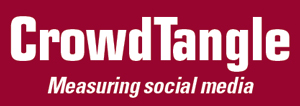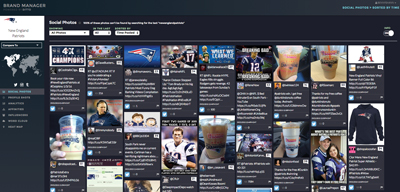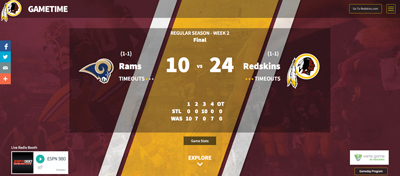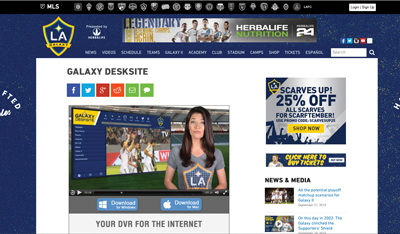The key questions around digital marketing, in many ways, have stayed the same since the dawn of the mainstream consumer Internet more than two decades ago.
How can a team or league use digital platforms to connect better with fans, and create new ones? How can sponsors break through the clutter to create maximum impact? How can these platforms be used better to create new forms of fan engagement, particularly on non-game days? How can a sports marketer better and more quickly identify the
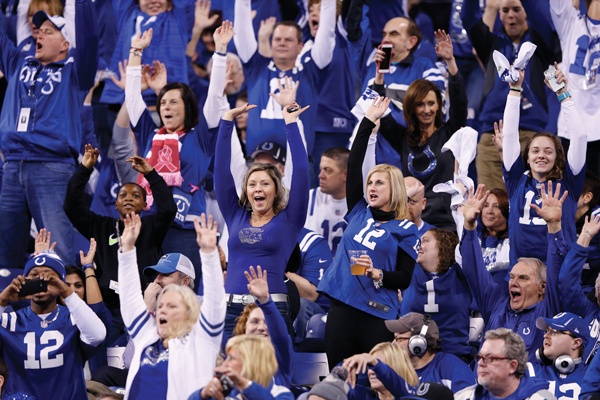 |
Teams and sponsors are using technology to target offers and content toward fans on an individual basis, providing for stronger activation and increased revenue.
Photo by: Getty Images |
right consumer and spend less time on the wrong ones?
Fueled in part by a historic run of venture capital entering the sports industry and advances in computing and mobile technologies, many of those age-old questions are now getting meaningful answers.
This section will explore a variety of emerging technologies in digital marketing and fan development, including visual searches that comb through photos on social media at massive scale, new ways of measuring online reach and engagement, and sending highly targeted, geo-located mobile alerts.
While many are still in an embryonic state, early results have shown deepened fan connections, new ticket sales, and heightened sponsor activation.
“I think we’re all trying to get away from old, mechanical marketing,” said Ali Manouchehri, chief executive of Virginia-based Zoomph, a developer of high-end online microsites and social media analytics tools. “We’re getting much closer to being able to embed that fan passion and affinity into every digital channel.”
Most every platform within digital media, from Web pages and email to social media and mobile alerts, has long been mined for marketing purposes, many to the point of user fatigue. But the element on any smartphone or computer that many users rely on and use the most on any given day — the calendar function — has stayed largely untouched.
Until now.
A fast-growing collection of teams, leagues, associations, college programs and retailers have embraced new solutions that allow them to convey their message within a fan’s calendar. Reminders of upcoming games, alerts for ticket on-sale dates and last-minute seat availabilities, and even individualized birthday and anniversary messages are now communicated through the calendar platform.
ECal, an Australia-based company that has described the calendar as the “last untapped marketing frontier,” has in a
matter of months partnered with dozens of pro and major college entities, including the New England Patriots, Washington Redskins, Boston Celtics, Major League Soccer and Duke University. In each instance, the teams and properties use eCal’s cloud-based software to talk to fans through their calendars.
Fans can opt into a variety of additional calendar listings beyond core game schedules, such as team-related TV programming listings, and season-ticket holder and corporate events, and set reminders against them. The teams and properties in turn keep the fan data generated through the system, allowing for mining within key revenue lines.
“This has really become a whole new category, a whole new communications channel,” said Patrick Barrett, eCal founder and chief executive. “Marketers are finding it harder than ever to capture the time and attention of consumers, and we’re right there in the middle of people organizing their time.”
The software works on a two-direction format — elements such as a time schedule can be synced directly into a user’s calendar. But events listed on the calendar, such as ticket on-sale dates, also can serve as a jumping-off point in which a fan links to a Web page or mobile app to purchase seats, and interacts with other team or league content.
ECal is also active in other areas of commerce, including retail, finance, education, and event and conference business. But the company says it is sports that has quickly become a leading category.
“Sports has definitely been pacing the market in terms of really proving the concept of calendar marketing,” Barrett said.
The digital media industry debate over the accuracy of online and mobile audience metrics, already running hot, has only amplified in recent years as the importance of distributing content on social platforms such as Facebook and Twitter has grown substantially.
Measuring the reach and efficacy of those external social media posts has traditionally proved a further challenge for many teams, leagues and sports media entities. But tools now exist to evaluate social media content in real time, in turn aiding marketers activating within those platforms.
CrowdTangle, a Baltimore-based social analytics startup, has quickly landed a top-tier portfolio of clients including MLB, the NHL, ESPN, Turner Sports, Whistle Sports, the New England Patriots and many others. The firm has done so by tracking social media accounts, measuring them against key comparables and rivals, and quickly
identifying top-performing posts across several variables.
Such straightforward and easily customizable metrics have shown themselves even more valuable as the often-changing algorithms used on many social platforms such as Facebook for searching and surfacing content have long confounded publishers, teams and properties.
“All the data that exists around [monthly uniques], people are increasingly realizing that it doesn’t tell you much, certainly not about time spent or repeat business,” said Brandon Silverman, CrowdTangle co-founder and chief executive. “But what’s more, people are consuming more and more content on these other platforms, and social metrics have become really important.”
The Patriots began using CrowdTangle’s platform over the summer, and so far in this young NFL season, the software has quickly proved invaluable.
“There’s so much of our content that is consumed directly on social now, so this really levels the playing field in terms of your content and learning what is really performing,” said Cecily Faenza, Patriots social media manager. “What we’re really getting is real-time best practices.”
If you’re wearing some kind of logo or brand emblem in a social media photo, Ditto Labs is probably going to find it. The same goes for any sort of smile, frown or other facial sentiment.
The Massachusetts-based startup has quickly made a name for itself in the emerging realm of visual search. The company sorts through tens of millions of social media posts shared publicly across platforms such as Twitter, Facebook, Instagram, Tumblr and Flickr, scanning for logos, brand marks and other identifying features of consumer sentiment.
Ditto Labs works across numerous sectors of commerce, but sports has quickly become a key area, given the highly engaged nature of many fans.
“Sports really seems to be among the most passionate and most public sectors out there,” said Josh Wachman, Ditto
Labs president. “Fans are typically very open about declaring their affinity.”
Using that fan openness, the visual search technology has been used by many pro teams to help answer key questions such as: Which fans have shown themselves to be passionate but are not already in traditional team customer-relationship management lists, and are there additional opportunities for ticket sales? Which product brands and categories do fans appear with the most or the least? Are existing team sponsors resonating well with the fan base?
In seeking to answer those and other similar questions, the visual search data can provide research delving far beyond traditional panel-based methods measuring consumer sentiment.
“Sports marketing is generally a rather mature area,” Wachman said. “The goals, broadly speaking, are the same as they have been for some time. The teams and leagues are looking to connect more deeply with their fans, and brands are also trying to speak to that audience through a team or a league or a player. But the visual data opens up a lot of a new ways to learn about brand affinities.”
In just a few short years, beacons have become the norm at many pro and college sports facilities, allowing fans to receive targeted, location-specific alerts on their smartphones while at the ballpark, stadium or arena.
Nearly all of those initial installations, however, have been focused on a team’s home facility, and have operated heavily in pushing coupons and discount offers and delivering club-based content such as game highlights and stats.
A second major phase of proximity-based marketing is now emerging based on geofencing at a team’s away or neutral-site games, and using the technology to create longer forms of engagement than couponing or straightforward content consumption.
A partnership between Gimbal and the University of Wisconsin, also involving partner mobile app developer
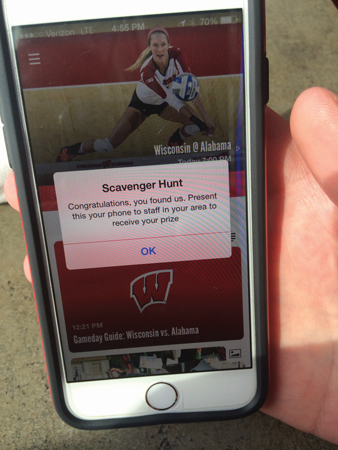 |
| Photo by: Gimbal |
YinzCam, typifies this trend. The alignment calls for creating mobile geofences around away and neutral-site games, such as the Badgers’ football season-opener in Arlington, Texas, against Alabama. Fans using the Badgers’ Game Day mobile app were automatically delivered new content as they arrived in the Dallas area and approached AT&T Stadium, allowing for an additional level of fan engagement away from the school’s own Camp Randall Stadium.
The app has expanded to include new fan activities such as a scavenger hunt to locate various team-related items and events. The expanded mobile capabilities also have given additional exposure for advertisers.
“There’s been a real move to use this technology to create a whole new layer of fan loyalty and relationship management,” said Kevin Hunter, Gimbal chief operating officer. “Fans really want to feel special, so the idea is to be more adaptive and use this for a lot more than just a dollar off a hot dog at the concession stand.”
Wisconsin may deploy the geofencing technology for basketball season.
“There’s an opportunity here to interact with our fans a whole different way, particularly when we’re traveling,” said Ben Fraser, Wisconsin’s director of external engagement.
In an era of widely distributed digital content, dedicated team and player microsites still have not only a place with fans, but a vibrant one.
Seeking to break through the clutter and noise of traditional digital sports media and their own primary websites, a fast-growing collection of pro teams have aligned with firms such as Virginia-based Zoomph to create customized online experiences for special events and team commemorations.
Recent examples of Zoomph’s microsite work have included an interactive destination highlighting the Miami Dolphins’ 50 years in the NFL, another in which fans of Dale Earnhardt Jr. can share their favorite memories of the NASCAR driver, and a newly created Washington Redskins Gameday that essentially acts as a virtual, continually updating game program complete with statistics, injury updates, game
analysis, social media integration and press conference video.
The microsite development work builds upon Zoomph’s existing work in real-time social media analytics.
“There is a real interest in longer-form storytelling online,” said Ali Manouchehri, Zoomph chief executive. “Teams, of course, want to engage with their fans. So what we’re trying to do is use data to help create intelligent, curated content and open up a whole new form of storytelling.”
In many instances, the microsites feature a single presenting sponsor, allowing for a level of marketing ownership and presentation for sponsors often not available elsewhere online.
“What we like to call it is right-brain technology, gaining a better understanding of how emotions are going to work and specifically where fan passions lie,” Manouchehri said.
While most of the digital media industry is pushing toward mobile as much as possible, California-based
DeskSite is veering the other way toward larger screens.
The company, backed by entertainment and sports industry heavyweights such as agent Leigh Steinberg and directors Peter Farrelly and Joe Pytka, offers what it calls “DVR For the Internet.” Subscribers to team-based
DeskSite channels have exclusive content downloaded automatically to their computer desktops, tablets and connected TVs, allowing for high-definition and buffer-free viewing even when offline.
DeskSite differs from most other digital video providers in several key ways. The company caps its advertising load, as a percentage of content viewed, to 10 percent, far below most any other medium. But it still typically
charges higher-than-normal advertising rates because it can target specifically to geographies, age groups and genders. Ads are also triggered only after watching a certain amount of content, as opposed to before every new video clip or every new session of watching. The service is free to consumers and totally ad supported.
In less than four years, DeskSite has aligned with more than two dozen NFL, NHL and MLS teams, generally operating on revenue-sharing agreements.
“We are delivering a TV experience to TV advertisers, but on the Internet,” said Richard Gillam, DeskSite chief executive. Gillam is a former U.S. Marine and competitive figure skater who was a key early figure in the rise of day trading on the U.S. stock market. “Being right on the desktop, we occupy beachfront property. But we think there’s a big opportunity to provide a far richer, more personalized experience to the fans and give teams a distinct touch point for them to deliver more of their core product.”
Users are asked to supply their age and gender when first signing up and then reconfirm that data after an initial period of content consumption.
“Having those two pieces of data, age and gender, allows us to shape an entirely different advertising experience,” Gillam said. “Most online ads are noise and mindless clicks, but we can offer a far greater degree of precision in front of a really engaged audience.”





